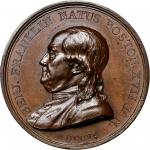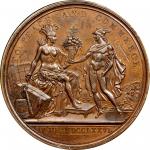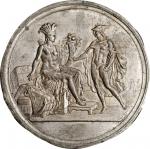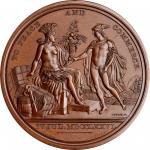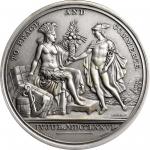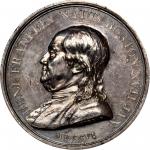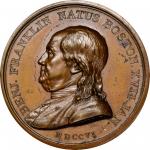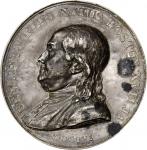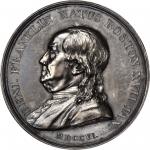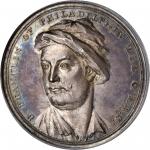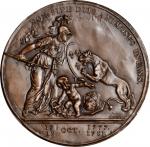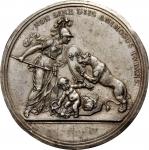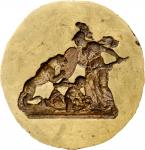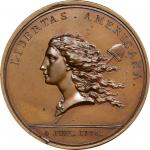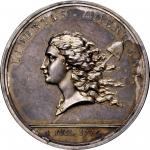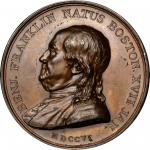1786 Benj. Franklin Natus Boston medal. Betts-620. Copper. Original dies. Paris Mint. 45.9 mm. 687.8 grains. 3.8 - 4.0 mm thick. Choice Mint State.Plain concave edge, collaring marks at 12:00 and 12:30 as seen on some Comitia Americana strikes. An exceptionally early striking from an early state of these dies, coined from a collar style in use ca. 1787-89. Choice medium brown with warm luster on both sides. A few tiny specks are seen, including one on Franklins jowls and one under B of BENJ. This is about as early a die state as a collector could hope to obtain for this classic medal.<p>Among the medals included in the Adams Collection, this is perhaps the most common in original form. After Franklins death, this medal would have been a must-have inclusion in any European or American cabinet of great men - and collecting medals was extremely popular at the time. The plain edge originals, struck before 1842, remain scarcer than the vast majority of numismatic items that cost the same amount yet have pretensions to popularity.<p><strong>Benjamin Franklin Natus Boston</strong><p>The exact circumstances that led up to Augustin Dupre creating a medal to honor Benjamin Franklin are unclear. There is little paper trail emanating from either of these gentleman, artist or subject, to indicate that a special anniversary or incident was being celebrated. Rather, this seems to be what has long been termed a "personal medal," that is, a medal to honor a figure whose character was admired by the artist who created it.<p>Sketches in the collections of the American Philosophical Society and Boston Public Library, as well as three retained in the Dupre estate, show the evolution of Dupres design concept for the reverse of this medal. Several drawings depict a fully grown Hercules - a play on the infant Hercules who represents America on the Libertas Americana medal - trampling two figures, one of whom wears a crown and holds a broken scepter. Eventually Dupre came upon versions of the Winged Genius design that were close to the adopted motif. The legend ERIPUIT COELO FULMEN SCEPTRUMQUE TYRANNIS, commonly translated as "He snatched lightning from the heavens and the scepter from tyrants," is typically attributed to Turgot, the French politician and economist. It first appeared on a print of Franklin dated 1778, and various versions of the phrase floated around France thereafter. The legend is found on one of Ninis large size Franklin portraits in terracotta, dated 1779, and its often found hand-inscribed on the back of the smaller and more commonplace 1777 Nini Franklin portraits as well.<p>Franklin said little about this medal, which may suggest that he heard little about it - the Betts-619 from original dies is rare enough today to suggest that very few of them were struck during Franklins lifetime. Indeed, by the time Franklin left his French home at Passy for good on July 12, 1785, Dupres celebratory medal was probably still a fairly well kept secret. His friend E.A. Gibelin, who helped design the reverse of the Libertas Americana medal, wrote him on February 7, 1785, on various topics and noted "M. Dupre le graveur men a montre une avec linscription eripuit coelo fulmen etc." or "Mr. Dupre the engraver showed me one with the inscription eripuit coelo fulmen etc." No other mention of this medal appears in Franklins papers, save a handbill advertising the Comte dEstaings 1790 work entitled "Appercu Hazarde Sur LExportation Dans Les Colonies," which was dedicated to Franklin and illustrated the Winged Genius medal on its title page.<p>As beautiful as Dupres first effort was, it was short lived and has proved a major rarity today. The reason the second medal, Betts-620, supplanted the first is clear from studying the medals: the initial reverse failed and was, unfortunately, replaced with a far less imaginative one. This second type was all that was available when Jefferson built the small collection to present to President George Washington, now conserved at the Massachusetts Historical Society. Sometime after Franklins death, the first reverse design was brought back again with a new copy die; as popular as Franklin was in life, he became perhaps more so in death. The original obverse die and the original replacement die (with wreath) also lived on for generations of restrikes. After 1842, these restrikes were marked on the edge with Paris Mint privy marks. They remain accessible enough to suggest that they were popular sellers throughout the 19th century in France and abroad.<p><strong>The Benj. Franklin Natus Boston Medal:</strong><p><strong>Obverse:</strong> Franklins profile faces left, based on the portrait bust by Houdon, with DUPRE F. on the shoulder truncation. The date MDCCVI beneath the bust represents the year of his birth, 1706. The legend BENJ. FRANKLIN NATUS BOSTON XVII JAN around the periphery completes the thought: "Benjamin Franklin born at Boston, January 17."<p><strong>First Reverse:</strong> A winged genius, symbolizing brilliance of thought, stands at center with one hand raised to the thunderbolt behind him. A lightning rod, invented by Franklin, attracts the bolt atop a temple at left. A broken scepter and crown lay on the ground at right. The peripheral legend ERIPUIT COELO FULMEN SCEPTRUMQUE TYRANNIS, or "He snatched lightning from the heavens and the scepter from tyrants," is perhaps the most famous aphorism about Franklin. In the exergue, Dupre takes full credit: SCULPSIT ET DICAVIT / AUG. DUPRE ANNO / MDCCLXXXIV or "Engraved and dedicated by Augustin Dupre in the year 1784."<p><strong>Second Reverse:</strong> A simple oak wreath contains the legend ERIPUIT COELO FULMEN SCEPTRUMQUE TYRANNIS. Below the wreath, the legend continues in three lines: SCULPSIT ET DICAVIT / AUG. DUPRE ANNO / MDCCLXXXVI<p><p><p><p>From the John W. Adams Collection. Acquired from Joseph Lepczyk’s sale of May 1982, lot 384.

